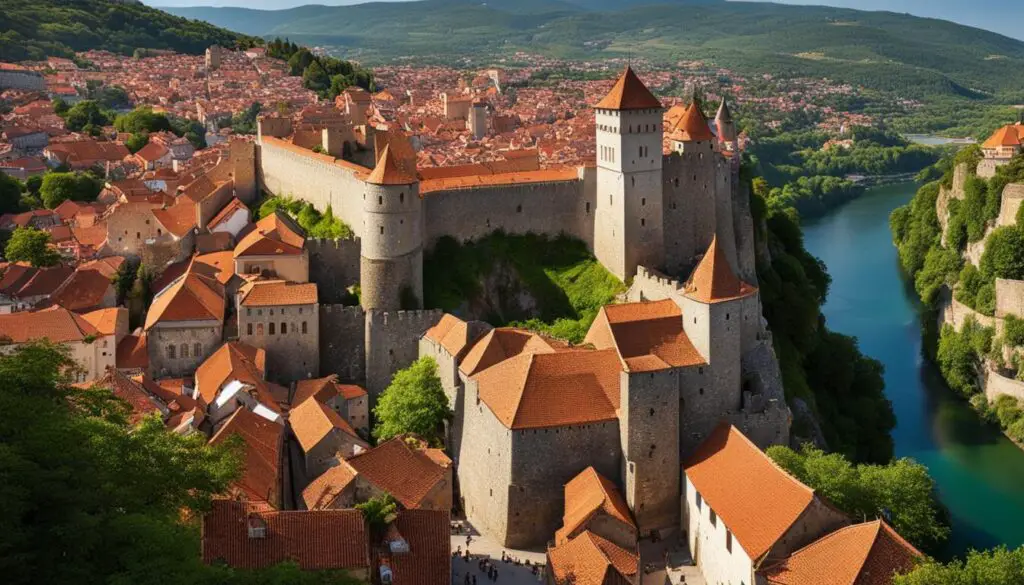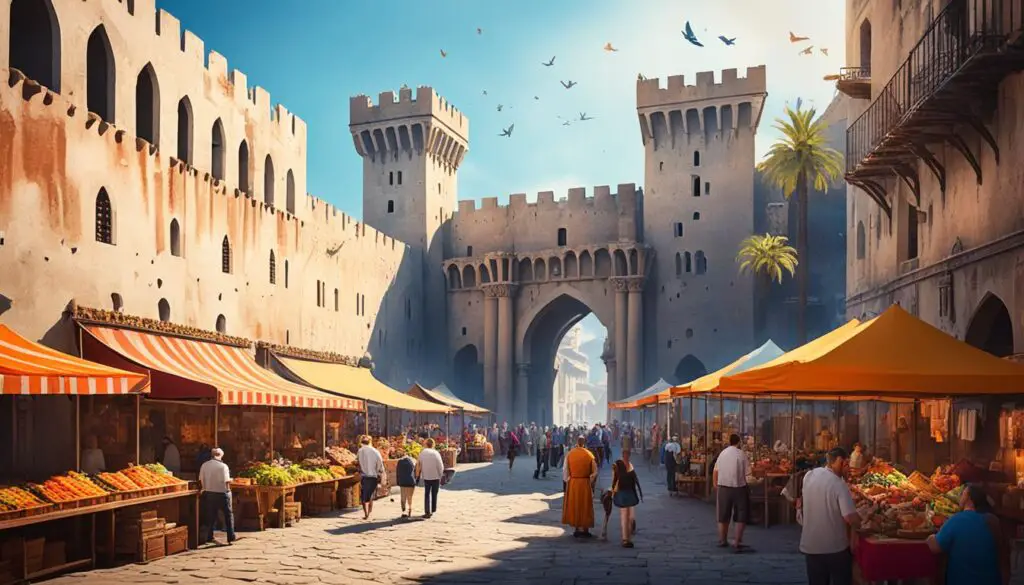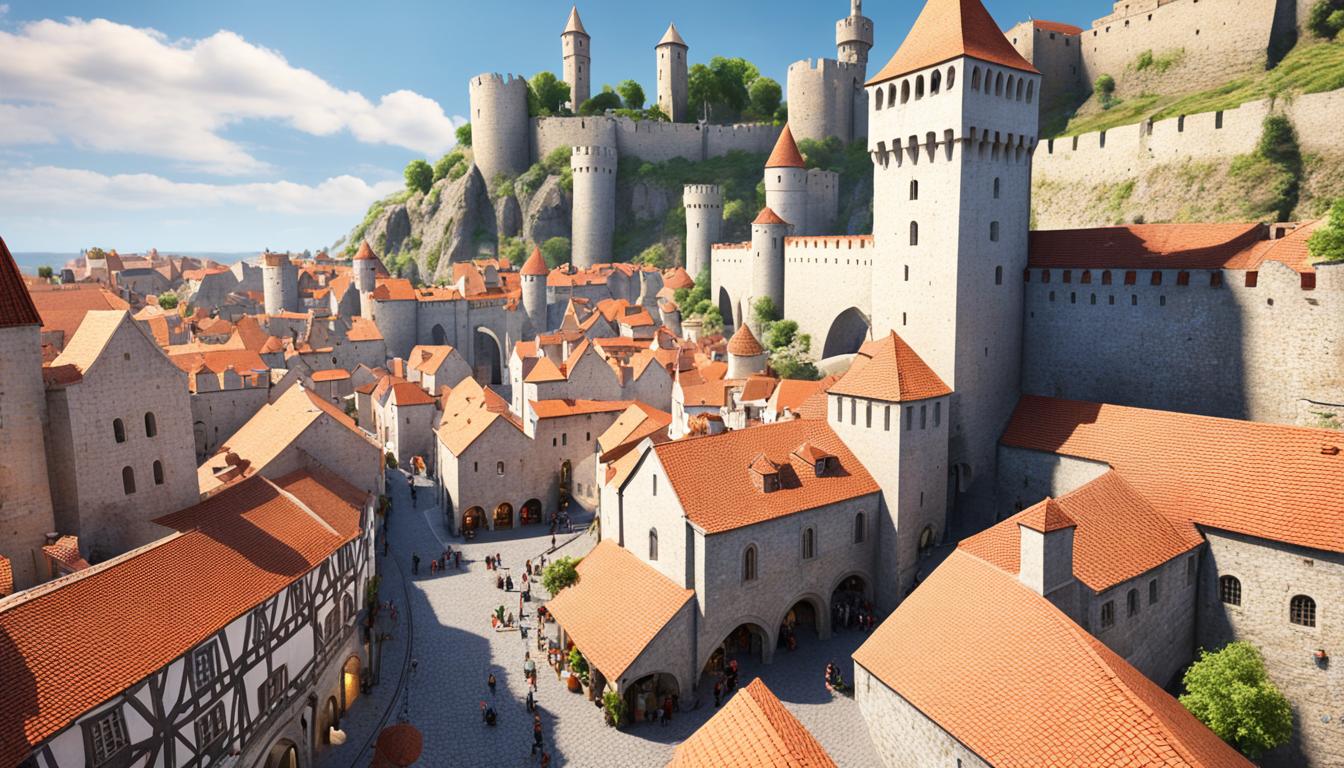Experience the enchantment of Carcassonne’s historic citadel and lower town, as you delve into the captivating beauty and rich history of this remarkable destination in France. Nestled in the picturesque region of Occitanie, Carcassonne is home to one of Europe’s most well-preserved medieval towns, boasting awe-inspiring architecture and a plethora of cultural treasures.
At the heart of Carcassonne lies the majestic citadel, known as La Cité, a testament to the city’s storied past. Step back in time as you stroll through its cobbled streets, marvel at its double-walled fortifications, and explore the iconic Château Comtal. The Basilica of Saints Nazarius and Celsus, with its intricate stained-glass windows, offers a glimpse into the religious heritage of the region.
As you venture beyond the citadel, you’ll discover the charm of Carcassonne’s lower town, Ville Basse. Meander along the scenic Canal du Midi, a UNESCO World Heritage site itself, and witness the bustling markets brimming with local delights. Indulge in the region’s gastronomic scene, savoring delicious cuisine and renowned wines that showcase the culinary prowess of southern France.
Immerse yourself in Carcassonne’s cultural vibrancy as you partake in lively festivals like the Festival de Carcassonne and witness the awe-inspiring fireworks on Bastille Day. The city’s timeless allure, paired with its historical significance, promises an unforgettable journey that will leave you with cherished memories.
Key Takeaways:
- Explore the remarkable citadel and lower town of Carcassonne in France to immerse yourself in its rich history and stunning architecture.
- Wander through the cobbled streets of La Cité and visit the magnificent Château Comtal and the beautiful Basilica of Saints Nazarius and Celsus.
- Experience the charm of Ville Basse, with its vibrant markets and picturesque Canal du Midi.
- Indulge in the gastronomic delights of Carcassonne, sampling the region’s exquisite cuisine and world-renowned wines.
- Discover Carcassonne’s cultural vibrancy through its lively festivals and events, such as the Festival de Carcassonne and Bastille Day celebrations.
The History of Citadel and Lower Town
The history of the citadel and lower town of Carcassonne is deeply rooted in the past, dating back to the Gallo-Roman period. Officially known as La Cité, the citadel played a vital role as a strategic stronghold in the defense of the region. Throughout its remarkable existence, Carcassonne witnessed the rise and fall of various rulers and endured invasions by the Visigoths, Saracens, and Crusaders.
In the 19th century, Carcassonne experienced a significant restoration process led by the acclaimed architect Eugène Viollet-le-Duc. This meticulous effort successfully preserved the medieval character of the city, allowing visitors to witness the grandeur of its rich history today. Carcassonne stands as a magnificent example of medieval military architecture, showcasing the strength and resilience of the past.

“Carcassonne stands among the few medieval cities continuing to full architectural unity. It is a scenic masterpiece with its fairylike appearance and exceptional historical charm.” – UNESCO World Heritage Committee
Key Moments in Carcassonne’s History:
- During the 4th century, Carcassonne served as a fortified Roman outpost protecting vital trade routes.
- The Visigoths established their presence in Carcassonne during the 5th and 6th centuries, leaving their mark on the city’s architectural heritage.
- In the 8th century, the Saracens conquered Carcassonne, significantly influencing its cultural and artistic development.
- The Crusaders seized Carcassonne in the 12th century, strengthening its defenses and contributing to its prominence as a stronghold.
- Architect Eugène Viollet-le-Duc led the extensive restoration work in the 19th century, ensuring the preservation of Carcassonne’s medieval identity.
Carcassonne’s captivating history transports visitors to a time when knights roamed its streets and besieging armies defended its walls. Today, tourists can immerse themselves in the medieval atmosphere, explore the remarkable architectural wonders, and discover the stories that have shaped this enchanting city.
Exploring the Majesty of Citadel and Lower Town
When visiting Carcassonne, exploring the citadel and lower town is a must-do experience. These two areas offer a captivating blend of historical charm and modern attractions that will delight any traveler.
Discovering the Citadel
The citadel, also known as La Cité, is the heart of Carcassonne’s medieval fortress city. Begin your exploration by entering through the Narbonnaise Gate, where centuries of history await. As you wander through the narrow lanes, marvel at the architectural wonders that surround you.
One of the highlights of the citadel is the Basilica of Saints Nazarius and Celsus. Step inside this magnificent church and be mesmerized by its stunning stained-glass windows, depicting scenes from biblical stories. The tranquility and beauty of the basilica offer a peaceful respite from the bustling streets.
Another must-visit site within the citadel is the Château Comtal. Climb its towers and walk along the ramparts to enjoy panoramic views of the picturesque countryside and the vibrant Ville Basse below. The Château Comtal also houses a museum that showcases the history and heritage of Carcassonne.
Exploring the Lower Town
Descend from the citadel into the lower town, known as Ville Basse. Here, you’ll find a different atmosphere with its own unique attractions. One of the main highlights of the lower town is the Canal du Midi, a UNESCO World Heritage site. Take a leisurely stroll along its banks or rent a bike to explore the charming waterway.
To immerse yourself in the local culture, don’t miss the bustling markets of Carcassonne. From fresh produce to handmade crafts, these markets offer a glimpse into the vibrant daily life of the city. Indulge in the delectable local cuisine, such as cassoulet, a hearty slow-cooked stew, and taste the flavors of Carcassonne.
Throughout the year, Carcassonne also hosts various cultural events and festivals that showcase the city’s rich heritage. One of the most renowned events is the Festival de Carcassonne, which brings together music, theater, and dance performances in the historic settings of the citadel and lower town. The city also celebrates Bastille Day with spectacular fireworks that light up the night sky.
| Attractions in Carcassonne | Description |
|---|---|
| Basilica of Saints Nazarius and Celsus | A stunning church with beautiful stained-glass windows |
| Château Comtal | A medieval castle with panoramic views of Carcassonne |
| Canal du Midi | UNESCO World Heritage site known for its scenic beauty |
| Local Markets | Bustling markets offering a variety of local products |
| Festival de Carcassonne | An annual cultural festival featuring music, theater, and dance performances |
Explore the majesty of Carcassonne’s citadel and lower town and immerse yourself in the rich history and vibrant culture of this enchanting destination.

Conclusion
Carcassonne, with its citadel and lower town, is a city that effortlessly blends history and charm. The meticulously preserved medieval architecture, enchanting cobbled streets, and formidable fortifications transport visitors back in time to a bygone era. Carcassonne’s rich historical past, coupled with its vibrant culture and delectable cuisine, make it an absolute must-visit destination in southern France. Whether you are a fervent history enthusiast, a connoisseur of fine food and wine, or simply in search of a unique travel experience, Carcassonne promises an unforgettable journey into the heart of medieval France.
Renowned for its awe-inspiring structures, Carcassonne exudes an undeniable historical charm that captivates travelers from around the globe. The citadel, known as La Cité, with its imposing walls and majestic Château Comtal, stands as a testament to the city’s storied past. The lower town, Ville Basse, offers its own allure with the serene Canal du Midi and bustling markets that showcase the region’s local flavors and artisanal treasures.
An excursion to Carcassonne is like stepping into a storybook, where the past intertwines with the present. The city’s medieval grandeur, coupled with its warm hospitality and abundant cultural experiences, creates a vibrant tapestry that enthralls all who visit. Uncover architectural marvels, stroll through enchanting streets, savor delicious regional cuisine, and partake in lively festivals. Carcassonne beckons you to explore its timeless wonder.
FAQ
What is the significance of the citadel and lower town of Carcassonne?
The citadel and lower town of Carcassonne are historically significant as one of the most well-preserved medieval towns in Europe and a UNESCO World Heritage site. They offer a rich history and stunning beauty for visitors to explore.
How old is the citadel, La Cité?
The citadel, also known as La Cité, dates back to the Gallo-Roman period, making it a truly ancient site with a long and fascinating history.
What can visitors see and do in the citadel and lower town of Carcassonne?
Visitors can wander through the cobbled streets, visit the majestic Château Comtal, explore the Basilica of Saints Nazarius and Celsus, enjoy panoramic views from the ramparts, and experience the vibrant markets and Canal du Midi in the lower town.
Who led the restoration work of Carcassonne in the 19th century?
The restoration work of Carcassonne in the 19th century was led by architect Eugène Viollet-le-Duc, whose efforts helped preserve the medieval character of the city.
Are there any festivals or events in Carcassonne?
Yes, Carcassonne hosts cultural experiences such as the Festival de Carcassonne and the famous Bastille Day fireworks, offering visitors a chance to immerse themselves in the local festivities.
What makes Carcassonne a must-visit destination in southern France?
Carcassonne’s well-preserved medieval architecture, rich history, cultural vibrancy, delightful cuisine, and charm make it a must-visit destination for travelers seeking a unique and unforgettable experience in the heart of medieval France.
